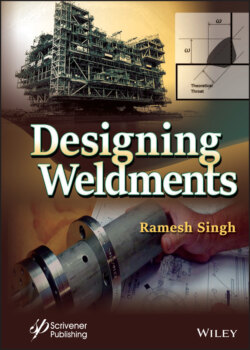Читать книгу Designing Weldments - Группа авторов - Страница 36
2.1.4 Low Temperature Properties
ОглавлениеLowering the temperature of metal profoundly affects fracture behavior, particularly of metals that have bcc structure. Strength, ductility, toughness and other properties are changed in all metals when they are exposed to temperature near absolute zero. The properties of metals at very low temperatures are of more than casual interest, because pipeline, welded pressure equipment and vessels are expected to operate satisfactorily at levels below room temperatures. For example, moderate sub-zero temperatures are imposed on equipment for de-waxing petroleum and for storage of liquefied fuel gases and pipelines. Much lower temperatures are involved in cryogenic services, metal temperature –100oC (–150 oF) and below. The cryogenic service may involve storage of liquefied industrial gases like oxygen and nitrogen. Down near the very bottom of the temperature scale, there is a real challenge for metals that are used in the construction of equipment for producing and containing liquid hydrogen and liquid helium, because these elements in liquefied form are increasingly important in new technologies. Helium in liquefied form is only slightly above absolute zero, which is 1 Kelvin (–273.16oC or –459.69oF).
Absolute zero (1oK) is the theoretical temperature at which matter has no kinetic energy, and atoms no longer exhibit motion. Man has yet to cool any material to absolute zero, so it is not known how metals would behave when cooled to this boundary condition.
However, metal components have been brought to the temperatures very close to absolute zero, hence it presents a special challenge to metals and welded components as they would be required to serve in this extremely low temperature.
On cooling below room temperature every metal will reach a temperature where the kinetic energy will be reduced to nil. The atoms of the element will move closer and the lattice parameters would become smaller. All these changes would affect the mechanical properties of the metal.
With above information on the physics of metal in mind, let us review the behavior of an un-notched specimen without flaws. It may be pointed out that in real life, there is no material without flaw, every material has some flaw in it, and hence the assumption to a material without flaw is more of hypothetical in nature. It is the flaw that has to be considered as initiator of the material behavior in the given environment.
Consider the graph in Figure 2.2 below, the material is ductile until a very low temperature, point A, where Y.S. equals the UTS of the material (σo = σu). Point A represents the NDT temperature for a flaw-free material. The curve BCD represents the fracture strength of a specimen containing a small flaw (a < 0.1mm). The temperature corresponding to point C is the highest temperature at which the fracture strength σf ≈ σo. Thus point C represents the NDT for a specimen with a small flaw.
The sub-ambient temperature dependence of yield strength σo (Rp0.2) and ultimate tensile strength σu in a bcc metal is shown in Figure 2.2 below.
Figure 2.2 Low temperature behavior of metals.
The presence of a small flaw raises the NDT of steel by about 200°F (110°C). Increasing the flaw size decreases the fracture stress curve, as in curve EF, until with increasing flaw size a limiting curve of fracture stress HJKL is reached. Below the NDT the limiting safe stress is 5,000 to 8,000 psi (~35 to 55 MPa).
Above the NDT the stress required for the unstable propagation of a long flaw (JKL) rises sharply with increasing temperature. This is the crack-arrest temperature curve (CAT). The CAT curve defines the highest temperature at which unstable crack propagation can occur at any stress level. Fracture will not occur for any point to the right of the CAT curve.
The temperature above which elastic stresses cannot propagate a crack is the fracture transition elastic (FTE). The temperature defines the FTE, at the point K, when the CAT curve crosses the Yield Strength, σo curve. The fracture transition plastic (FTP) is the temperature where the CAT curve crosses the Ultimate Tensile Strength σu curve (point L). Above this temperature the material behaves as if it is flaw-free, for any crack, no matter how large, cannot propagate as an unstable fracture.
